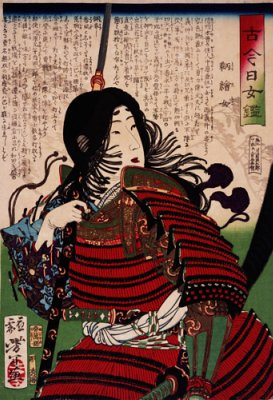Female Samurai in Ancient Japan
By Melanie Shintaku
| |
Almost always eliminated from popular knowledge of warriors in ancient Japan, is the role women played as wives of the samurai or warriors in their own right.
The primary role of women of the samurai class had been to support the family and their husbands. During the Kamakura Period (1185-1333), women were responsible for raising their children with the proper samurai upbringing. The women of this period were allowed rights to inheritance and to bequeath property. They controlled the household finances, and managed the staff. Women were also expected to defend their homes in times of war. This period in Japanese history produced some of the most famous women: Tomoe Gozen, wife of Minamoto Yoshinaka and a fierce warrior very proficient with sword and bow; and Hojo Masako (1157-1225), wife of Minamoto Yoritomo and known as the "nun shogun". In keeping with customs of the time, Hojo Masako became a Buddhist nun upon the death of her husband in 1199. After Yoritomo's death, Hojo Masako along with her father and son, usurped the real ruling power from her dead husband's ruling Minamoto clan to her own Hojo clan. Her efforts gave the Hojo clan true power over the now 'puppet regime' Minamoto clan.
After this period in Japanese history, daughters were used in power struggles as pawns in marriage. This practice greatly reduced the influence of women in the samurai class. Eventually, by the 17th century, women had lost their previous rights of inheritance and the ability to bequeath land. However, they were still expected to raise the children with the proper samurai education and defend the home in times of war.
One of these women of this period, Nakano Takeko, was highly skilled with the weapon called "naginata." The naginata is a long staff with a curved blade (looks like a small katana) at one end. The story of Nakano Takeko is in her defense of Wakamatsu Castle along with samurai of the Aizu clan. The Aizu clan were supports of the shogunate. Their battle (1868) was with the imperial forces and its restoration of Japan and elimination of the samurai class (you may be familiar with this time in history from the movie "Last Samurai"). The Aizu clan were greatly outnumbered -- 20,000 to 3,000. So the Aizu samurai put anyone who could use a weapon to use. A small band of women of the castle organized a unit to fight on the front line of this battle. Nakano Takeko charged into enemy lines, cutting down many men. She was only stopped by being shot in the chest. In order to avoid being taken by the enemy, her sister Yuko removed Nakano's head, as they had previously agreed upon, and Yuko took the head home in honor. Today there is a monument erected to Nakano Takeko at the temple "Aizu Bangemachi" in the Fukishima province of Japan.
Today in Japan, women are active in various martial arts and gained recognition by winning gold in the 2004 olympics in Judo.
Content copyright © 2006-2020 by Melanie Shintaku. All rights reserved.
This content was written by Melanie Shintaku. If you wish to use this content in any manner, you need written permission.

 fuad_kamal
fuad_kamal